Buy one component and save 10% on up to 2 cables. Buy 2 components and get 4 free cables. Free shipping on USA orders over $700.
Buy one component and save 10% on up to 2 cables. Buy 2 components and get 4 free cables. Free shipping on USA orders over $700.
AHB2 Tri-Amp Setup - Ellery Coffman
The following photos and system descriptions were provided to us by one of our customers, Ellery Coffman. He has put together an amazing system and has carefully treated his room with acoustic absorbers. Nicely done!

Home Theater Featuring 10 Benchmark AHB2 Power Amplifiers
Hi Rory,
Thanks again for your help. For two speakers, it is truly unbelievable how real this tri-amp system sounds; it is nothing short of jaw dropping! It truly sounds better than the $200k+ setups I've heard in some of the high-end audio shops I've been to.
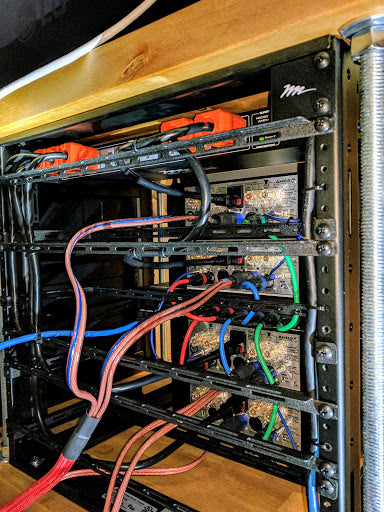
It took an entire weekend, but I built a rack by repurposing some shelves I made, rack mounted four of the AHB2's you sent, soldered custom length Canare star quad cables (after seeing John Siau's YouTube video), and also added the Neutrik speakon connectors you recommended. I can't wait until I move to hear this in surround; it is going to be truly jaw dropping with the AIX tracks I have. For each speaker: one AHB2 is used to drive the midrange and tweeter and one AHB2 drives the woofer.
System Details
The custom Windows 10 PC uses JRiver and RME's ASIO hammerfall driver. It sends AES out from an RME HDSPe AES-32 sound card to the Xilica XD4080's AES input. The Xilica does FIR filtering for the WF/MR/TW filters and the DAC that feeds the AHB2 amps.

Of course the passive crossovers were removed from the speakers as I am striving for best at any price sound... and I think I'm there. The only thing that might be better is using software based FIR filtering and buying a bunch of DAC3's!
Update October 2020

Since the original 2017 post, Ellery has made a number of upgrades to his already outstanding system:
- Tri-amped center speaker
- Five level-matched and time-aligned subwoofers
- Water-cooled PC in custom chassis to match the AHB2 amplifiers.
His home theater now features 10 AHB2 power amplifiers.
In Ellery's words:
"I'm still very impressed with the amps. In fact, even three years later I still get goosebumps when listening to certain tracks."
Photos
All photos courtesy of Ellery Coffman
Room Treatments
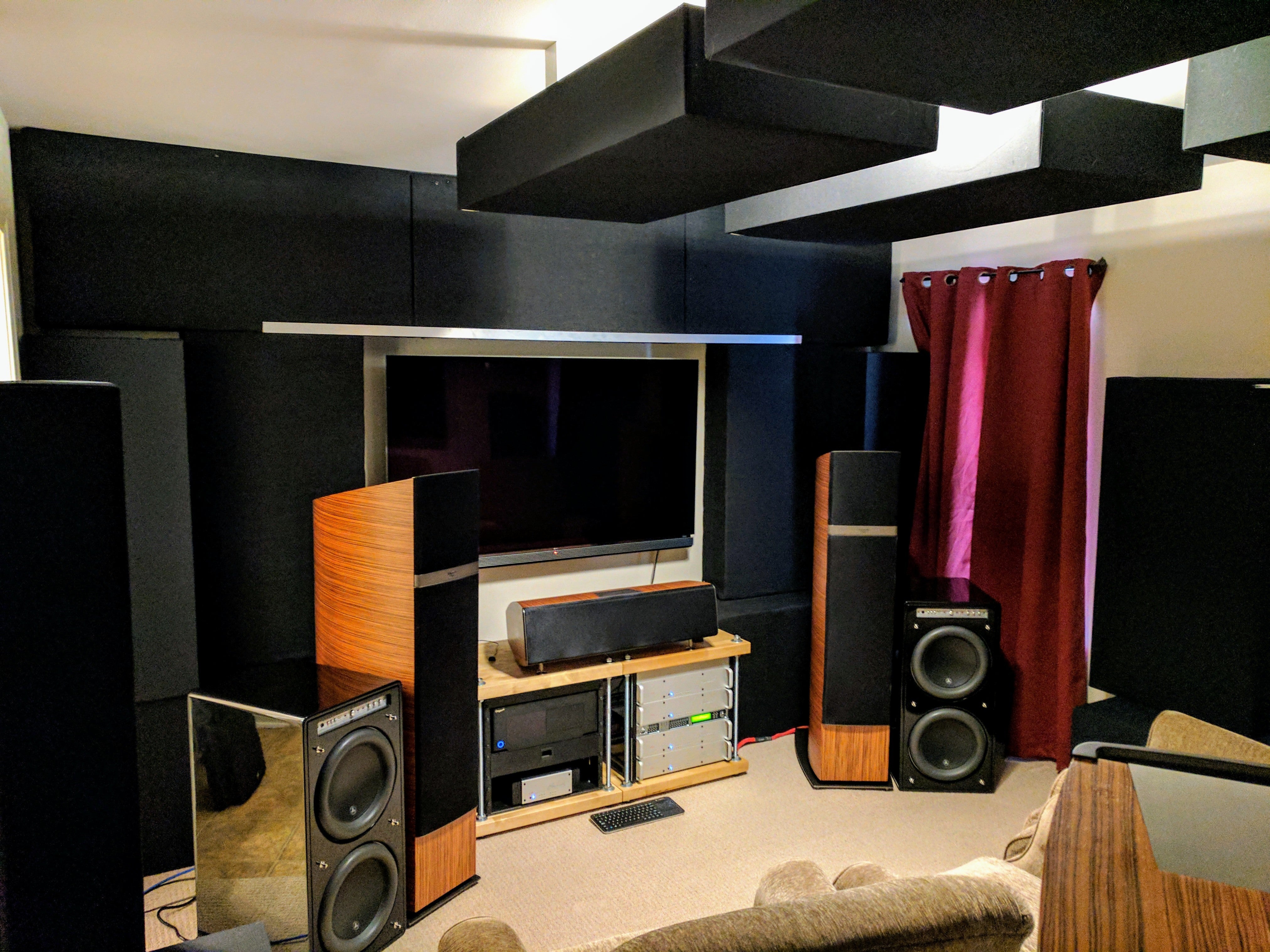
Front, Side and Ceiling Room Treatments
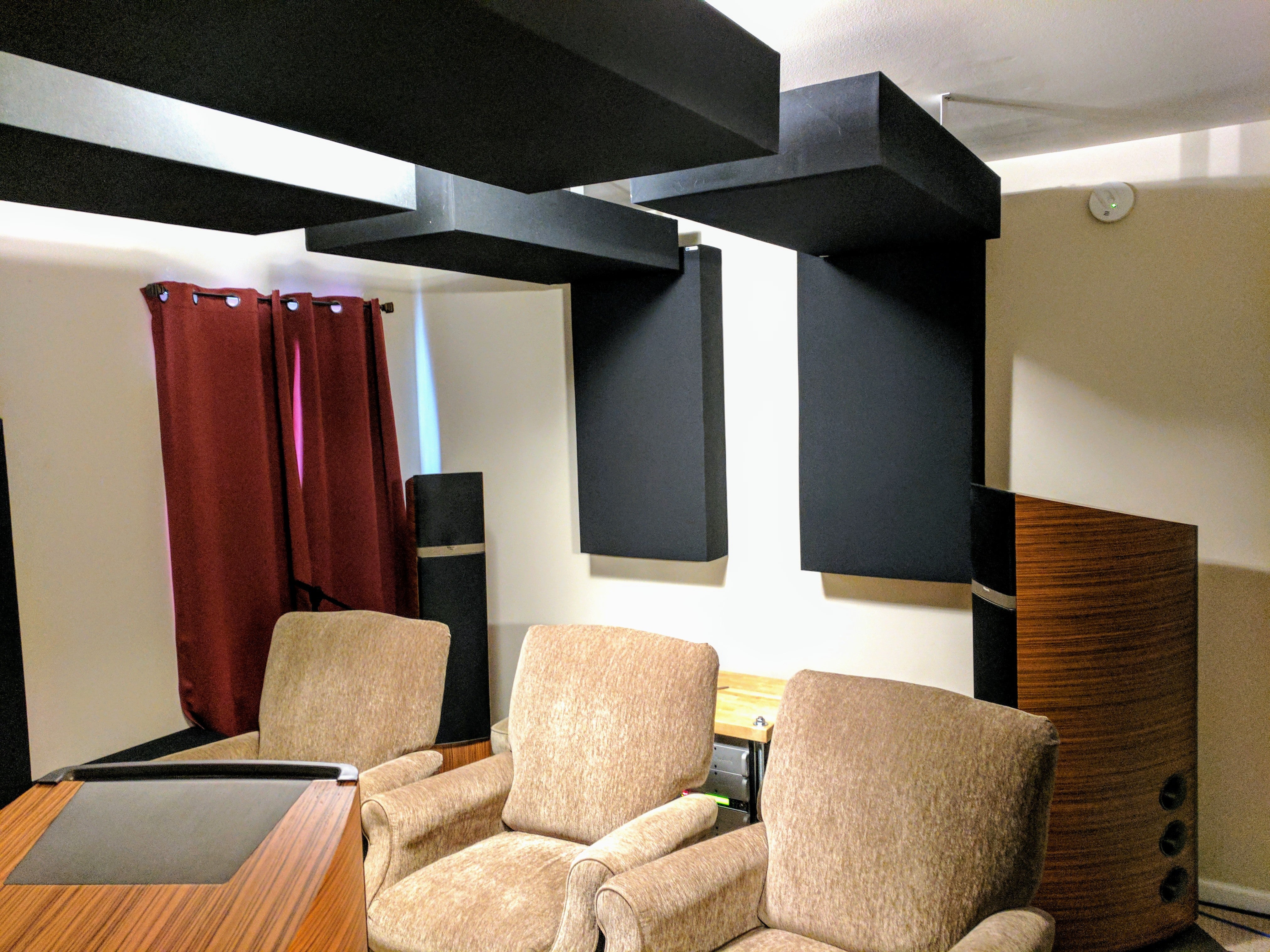
Rear Wall and Ceiling Room Treatments

Rear of Room Showing Earthworks Measurement Mic at Listening Position
Rack Details

Front Rack with Custom Water-Cooled PC (Upper Left Corner)

Custom Water-Cooled PC

Heat Sinks on Water-Cooled PC

Front Equipment Rack Featuring 6 AHB2 Power Amplifiers

Rear Equipment Rack Featuring 4 AHB2 Power Amplifiers
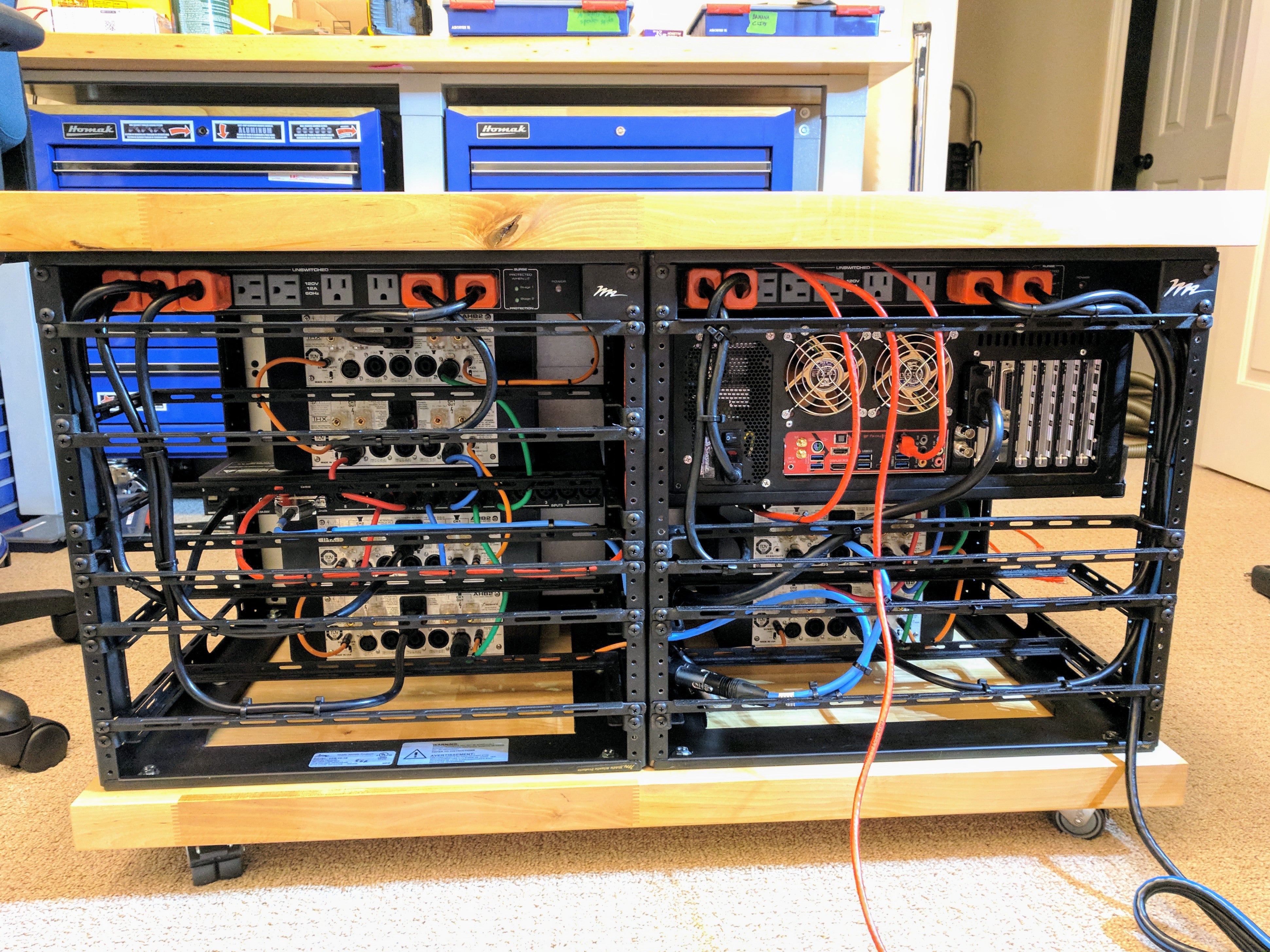

Rear of Main Equipment Rack
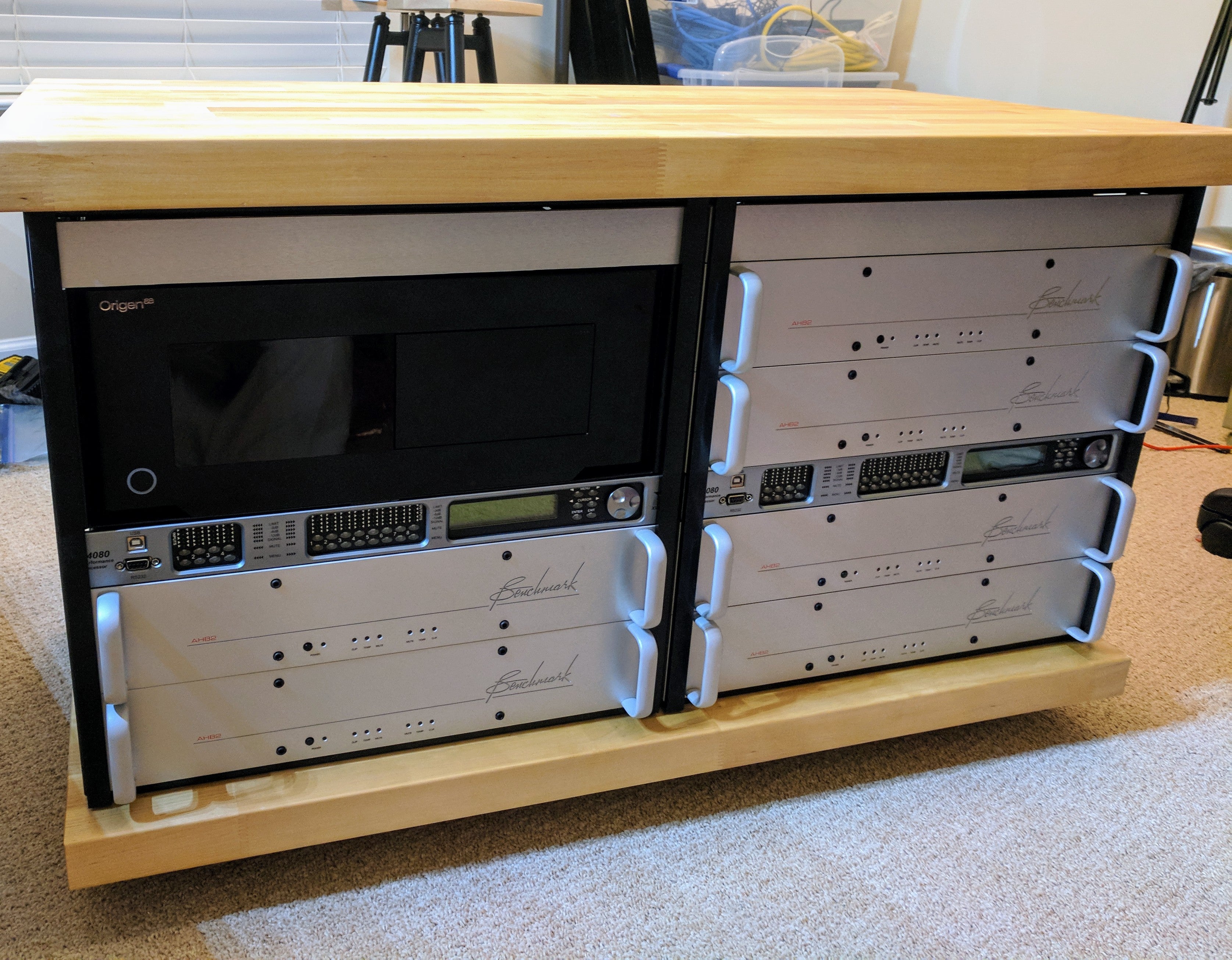
Front Equipment Rack (Before Adding Water-Cooled PC)
Leave a comment
Comments will be approved before showing up.
Also in Audio Application Notes

How Loud is the Distortion from Your Power Amplifier?
by John Siau August 08, 2025
Would you put a Washing Machine in your Listening Room?
If the answer is no, you may be surprised to discover that the distortion produced by your power amplifier may be louder than the noise produced by a major appliance.
Don't believe me? Take a look at Stereophile's test reports:
We selected 7 power amplifiers from Stereophile's top list of recommended amplifiers.
We took Stereophile's "THD+N vs. Power" plots for each, and replotted the data in a format that shows the loudness of the THD+N at the listening position.
The results are shocking!
Amplifier THD+N is louder than expected!
The distortion from your amplifier may be louder than a washing machine on the spin cycle, or it may be totally silent. How does yours perform? The answer is hidden in Stereophile's THD+N plots.
This application note reveals the hidden truth:
"The Distortion from your Power Amplifier may be Louder than a Washing Machine!"
I know, it sounds crazy, but this is what the measurements show!

Interpolator Overload Distortion
by John Siau November 20, 2024
Most digital playback devices include digital interpolators. These interpolators increase the sample rate of the incoming audio to improve the performance of the playback system. Interpolators are essential in oversampled sigma-delta D/A converters, and in sample rate converters. In general, interpolators have vastly improved the performance of audio D/A converters by eliminating the need for analog brick wall filters. Nevertheless, digital interpolators have brick wall digital filters that can produce unique distortion signatures when they are overloaded.
10% Distortion
An interpolator that performs wonderfully when tested with standard test tones, may overload severely when playing the inter-sample musical peaks that are captured on a typical CD. In our tests, we observed THD+N levels exceeding 10% while interpolator overloads were occurring. The highest levels were produced by devices that included ASRC sample rate converters.

Audiophile Snake Oil
by John Siau April 05, 2024
The Audiophile Wild West
Audiophiles live in the wild west. $495 will buy an "audiophile fuse" to replace the $1 generic fuse that came in your audio amplifier. $10,000 will buy a set of "audiophile speaker cables" to replace the $20 wires you purchased at the local hardware store. We are told that these $10,000 cables can be improved if we add a set of $300 "cable elevators" to dampen vibrations. You didn't even know that you needed elevators! And let's not forget to budget at least $200 for each of the "isolation platforms" we will need under our electronic components. Furthermore, it seems that any so-called "audiophile power cord" that costs less than $100, does not belong in a high-end system. And, if cost is no object, there are premium versions of each that can be purchased by the most discerning customers. A top-of-the line power cord could run $5000. One magazine claims that "the majority of listeners were able to hear the difference between a $5 power cable and a $5,000 power cord". Can you hear the difference? If not, are you really an audiophile?

